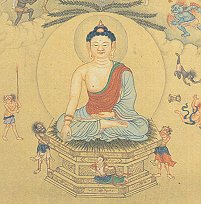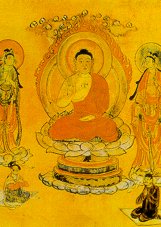
|
Contents
68.2 Perfect Harmony of the Six Characteristics of Dharmas 68.3 The Ten Mysteries 68.4 Remarks 68.1 The Illustration with the Golden Lion 'On the Golden Lion' [金獅子章], a treatise written by Master Fa-tsang [法藏], is a very significant scripture to illustrate the Hua-yen doctrines. First of all, it illustrates the Principle of Dependent Arising. Gold has no inherent nature of its own. The form of the lion is made as the result of the craftsman making it. Many other forms (phenomena) can be arisen from gold (noumenon). Secondly, it illustrates the relationship between form and emptiness. The form is unreal, but what is real is gold. The name 'lion' is given to the form, thus the real lion is non-existent. Moreover, any form of gold is also non-existent (empty). Emptiness has no mark of its own, it is through forms that emptiness is revealed. Thirdly, it illustrates the Three Characters as advocated by Fa-hsiang [法相] sect. The lion seems to exist in its form because of our illusory perception, which represents the Character of Universal Imagination [偏計執性]. The manifestation of gold in the form of the lion appears to be existing under dependent origination, which represents the Character of Dependent Origination [依他起性]. Irrespective of any form, the nature of gold never changes, which represents the Character of Perfect Reality [圓成實性]. Fourthly, it illustrates the non-existence of form. When the gold completely takes in the lion, there is no form of lion to be found. Fifthly, it illustrates the Truth of No-birth. There is nothing apart from gold in its existence. Through the lion, it comes into and goes out of its form. The substance of the gold, neither increases nor decreases.
Seventhly, it illustrates the Ten Mysteries. It will be elaborated in section 68.3 Eighthly, it illustrates the Perfect Harmony of Six Characteristics of Dharmas. It will be elaborated in section 68.2. Ninthly, it illustrates the achievement of the Perfect Wisdom of Bodhi. When we see the lion, we are free from any attachment immediately, as we understand all illusions are in reality non-existent. Tenthly, it illustrates the Entering of Nirvana. When we look at the lion and the gold, the marks of both are exhausted. The mind is tranquil and free from all hindrances. As the source of all suffering is forever cut off, one will enter into Nirvana. 68.2 Perfect Harmony of Six Characteristics of Dharmas [六相圓融] According to Hua-yen doctrine, no Dharma exists independently, for each possesses six characteristics immanently -- generalness [總相] and specialty [別相], similarity [同相] and diversity [異相], integration [成相] and disintegration [壞相]. Just as the gold lion illustrated in Fa-tsang's [法藏] treatise " On the Golden Lion" [金獅子章], the lion represents the character of generalness or wholeness, while its organs and limbs, etc., represent the character of variety and specialty, being different in their functions. The fact that they come in existence simultaneously as one dependent-arising represents the character of universality or similarity. However, the eyes, ears, and so on remain in their own places without interfering each other; this represents the character of diversity or particularity. The combination of all parts of the body to make up a lion represents the character of formation or integration. Lastly, the body of gold lion can be broken into pieces with different organs: it represents the character of disintegration.
It is generally difficult to understand the Hua-yen philosophy. As we live in a 3-dimensional world, we use to adopt the 'one at a time' and the shifting realm' approach in our human mind. It is just like that we cannot handle several phones calls at the same moment, and we cannot see all the objects in the room simultaneously. From the Buddhist point of view, it is our 'obstruction' to get access to the phenomenal world. However, this approach is entirely different from the omniscient power of the Buddha. The latter can see all things in numerous realms simultaneously, which are inter-penetrating with each other. It is because the Buddha has broken through all the obstructions / 'the boundary walls' completely in different realms. Being totally free from ignorance, the Buddha realizes in the state of Simultaneous Non-obstruction (in Buddhism, obstruction simply refers to ignorance). Another remark is the comparison of the doctrines between Hua-yen and Tien-tai [天台]. Originated in China, both of them attempted to establish a comprehensive system to embrace all the Buddha's teachings. Tien-tai sect developed during 6th and 7th century, while Hua-yen during 7th and 8th century. With respect to the noumenon and phenomenon, Tien-tai emphasized the relationship between noumenon and phenomenon, while Hua-yen emphasized the relationship between one phenomenon and another. We will discuss Tien-tai sect in the future chapters. |
 Sixthly,
it illustrates the Five Periods of Buddha's teachings. The golden
lion is ever changing in its form, as it is a product of dependent
origination. It represents the teaching of Hinayana. No permanent
form of the golden lion can be found, thus it is nothing but emptiness.
It represents the Preliminary Teaching of Mahayana. All that which
is dependent origination is not permanent in existence, and therefore
it is truly empty. The co-existence of both form and emptiness is
the Final Teaching of Mahayana. The two characters of form and emptiness
mutually depend on and annul each other. This is the state that
the ideas of both beings and non-beings vanish, and that words and
speech cannot express. It represents the Sudden Teaching of Mahayana.
When all false feelings and wrong ides are eliminated and the true
substance is revealed, everything becomes merged into one identity
- the Absolute. The all is the one, for they are empty in substance.
The one is the all, for it manifests all phenomena and Dharmas.
It represents the Round or Complete Teaching of Mahayana.
Sixthly,
it illustrates the Five Periods of Buddha's teachings. The golden
lion is ever changing in its form, as it is a product of dependent
origination. It represents the teaching of Hinayana. No permanent
form of the golden lion can be found, thus it is nothing but emptiness.
It represents the Preliminary Teaching of Mahayana. All that which
is dependent origination is not permanent in existence, and therefore
it is truly empty. The co-existence of both form and emptiness is
the Final Teaching of Mahayana. The two characters of form and emptiness
mutually depend on and annul each other. This is the state that
the ideas of both beings and non-beings vanish, and that words and
speech cannot express. It represents the Sudden Teaching of Mahayana.
When all false feelings and wrong ides are eliminated and the true
substance is revealed, everything becomes merged into one identity
- the Absolute. The all is the one, for they are empty in substance.
The one is the all, for it manifests all phenomena and Dharmas.
It represents the Round or Complete Teaching of Mahayana. The
Ten Mysteries expounded by Master Fa-tsang [法藏],
are regarded as the elaboration of the Non-obstruction Dharmadhatu
of Event against Event, one of the four Dharmadhatus. If one understands
the Ten Mysteries thoroughly, one will enter the Wisdom Sea of Avatamsaka
Sutra. The Ten Mysteries in Hua-yen's doctrine are as follows:
The
Ten Mysteries expounded by Master Fa-tsang [法藏],
are regarded as the elaboration of the Non-obstruction Dharmadhatu
of Event against Event, one of the four Dharmadhatus. If one understands
the Ten Mysteries thoroughly, one will enter the Wisdom Sea of Avatamsaka
Sutra. The Ten Mysteries in Hua-yen's doctrine are as follows:

